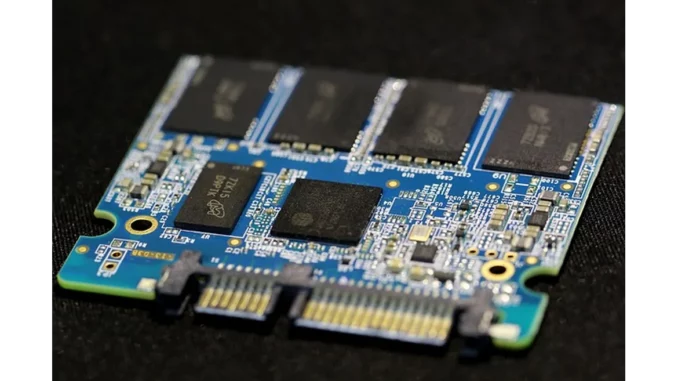
Summary
Optimising QLC SSDs with CSAL: Navigating the Future of Data Storage
As global data production surges, the quest for efficient, high-capacity storage solutions intensifies. Quad-Level Cell (QLC) SSDs, known for their storage density, face challenges in endurance and write-intensive performance. Enter the Cloud Storage Acceleration Layer (CSAL), an open-source tool poised to enhance QLC SSDs’ capabilities. Developed through industry collaboration, CSAL aims to redefine data storage efficiency, promising improvements in performance and lifespan.
Main Article
The Rise of QLC SSDs
Quad-Level Cell (QLC) SSDs have emerged as a transformative force in NAND flash technology, offering substantial storage capacity within the same physical space. These SSDs store four bits per cell, thereby achieving higher densities than Single-Level Cell (SLC), Multi-Level Cell (MLC), and Triple-Level Cell (TLC) counterparts. This makes QLC SSDs an attractive option for applications demanding large data volumes at a lower cost per gigabyte.
However, the benefits of QLC SSDs come with notable trade-offs. The primary issue is endurance, as the increased number of bits per cell imposes higher stress on NAND cells during write operations. This results in a reduced lifespan and reliability, particularly for write-intensive applications. Additionally, QLC SSDs typically exhibit slower write speeds compared to their SLC, MLC, and TLC counterparts. These limitations have spurred the development of innovative solutions to optimise QLC technology.
The Advent of CSAL
The Cloud Storage Acceleration Layer (CSAL) was developed to address the challenges posed by QLC SSDs. As an open-source software tool, CSAL enhances the performance and endurance of QLC SSDs by providing a host-based Flash Translation Layer (FTL) within the Storage Performance Development Kit (SPDK). This sophisticated management of I/O flow from the host optimises data placement and I/O paths, thereby improving write performance and extending the lifespan of QLC SSDs.
Initially conceived through collaborations between industry leaders such as Solidigm and Alibaba, CSAL was designed to meet the performance needs of Alibaba’s Elastic Cloud Storage (ECS). Over time, the tool has evolved into a powerful resource for optimising QLC SSDs, making them viable for a broader array of applications.
Revolutionising Data Storage
The introduction of CSAL has the potential to revolutionise how QLC SSDs are utilised in data storage environments. By mitigating the limitations of QLC technology, CSAL opens new avenues for deploying high-density storage solutions in data centres and cloud infrastructures. This is particularly relevant for read-intensive workloads, where the cost-effectiveness of QLC SSDs can be maximally leveraged.
Moreover, CSAL’s open-source framework fosters innovation and collaboration within the storage community. As developers contribute to the CSAL ecosystem, its capabilities are expected to expand, further enhancing the performance and reliability of QLC SSDs. This collaborative approach not only benefits individual organisations but also propels advancements in storage technology as a whole.
Transforming QLC to SLC
In parallel with CSAL’s enhancements, tech enthusiasts have explored a DIY approach to further improve QLC SSD performance. By modifying QLC SSDs to operate in Single-Level Cell (SLC) mode, significant gains in endurance and speed are achievable, albeit at the cost of reduced storage capacity. This method, pioneered by innovators like Gabriel Ferraz, involves reconfiguring NAND flash chips to function as SLC chips, drastically improving the drive’s durability and speed, while sacrificing storage volume.
Detailed Analysis
The development of CSAL and the DIY transformation of QLC SSDs into SLC SSDs underscore a broader trend in the data storage industry towards customisation and optimisation. As data production continues to escalate, the need for efficient, cost-effective storage solutions has become paramount. The ability to enhance existing technology through open-source tools and community collaboration offers a promising pathway for meeting these demands.
CSAL represents a critical step towards addressing the inherent limitations of QLC SSDs, while the DIY approach highlights the potential for user-driven modifications. Together, these developments illustrate the diverse strategies being employed to push the boundaries of NAND flash technology, ultimately benefiting users seeking enhanced performance and endurance in their storage solutions.
Further Development
The future of QLC SSDs, bolstered by solutions like CSAL, appears promising as data storage demands persist in their upward trajectory. As the storage industry continues to innovate, CSAL’s focus on improving write performance and endurance positions QLC SSDs as a viable option for a wider range of applications, from cloud storage to enterprise data centres.
The ongoing evolution of CSAL, coupled with the potential for user-driven modifications, suggests that the landscape of data storage is poised for continued transformation. As the CSAL ecosystem expands and more users experiment with QLC-to-SLC transformations, the industry stands to witness new approaches to optimising storage solutions. Readers are encouraged to stay engaged with this unfolding narrative as further developments and insights emerge from this dynamic sector.

